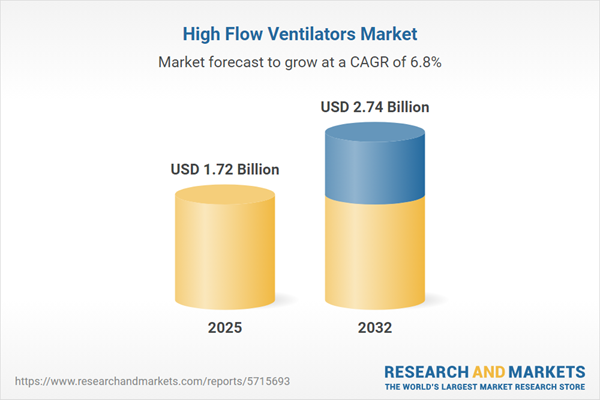Speak directly to the analyst to clarify any post sales queries you may have.
Amid ongoing change in respiratory care, senior healthcare decision-makers are navigating complex choices to ensure effective, sustainable delivery. The high flow ventilators market demands both targeted technology strategies and actionable insights to drive operational performance and patient outcomes.
Market Snapshot: High Flow Ventilators Market
Between 2024 and 2025, the global high flow ventilators market expanded from USD 1.61 billion to USD 1.72 billion, with forecasts projecting growth to USD 2.74 billion by 2032 and a compound annual growth rate (CAGR) of 6.81%. This trajectory is fueled by widespread adoption of advanced respiratory care in acute and chronic clinical environments. Integrated patient monitoring, critical care innovations, and a heightened focus on elderly and chronic disease populations all contribute to the expanding market. Adoption trends vary between mature and developing regions, driven by infrastructure, regulatory landscape, and shifting clinical needs.
Scope & Segmentation
This market analysis delivers detailed segmentation and relevant insights to inform strategy and investment for senior decision-makers:
- Product Type: Includes specialized portable ventilators with backup batteries and stationary models such as standalone and wall-mounted units, meeting diverse facility requirements.
- Operation Mode: Covers invasive solutions for endotracheal and tracheostomy care, as well as non-invasive systems using full face masks and nasal cannulae, supporting tailored therapy.
- Patient Type: Designed for adults, pediatrics, and neonates, enabling consistent respiratory support in intensive, ambulatory, and outpatient care contexts.
- End User: Penetration spans independent clinics, public and private hospitals, networked institutions, and residential care, reflecting a wider trend toward decentralized and patient-centered models.
- Flow Rate: Devices offer a range of flow rates, equipping clinicians with flexibility to adapt therapy as patient needs evolve in acuity and setting.
- Regional Coverage: Insight is provided into the Americas, Europe, Middle East & Africa, and Asia-Pacific, with each region influenced by distinct economic environments and regulatory nuances in respiratory care adoption.
- Company Trends: Profiles leading manufacturers such as Fisher & Paykel Healthcare, ResMed, Philips, GE, Hamilton Medical, Medtronic, Drägerwerk, Smiths Group, Vyaire Medical, and Vapotherm, noting shifts in collaboration and market strategy.
Key Takeaways for Decision-Makers
- Sensor technologies combined with machine learning enable more effective ventilation therapy, enhance real-time monitoring, and support workflow efficiency for clinicians managing complex respiratory cases.
- Increased collaboration among manufacturers, technology firms, and research bodies has accelerated the release of modular ventilator systems able to integrate into evolving clinical workstreams.
- Adoption of portable and ergonomic ventilator designs is advancing, supporting deployment in outpatient and residential settings, while helping foster patient independence and continuity of care.
- Reimbursement frameworks emphasize outcomes-based models, encouraging value-driven procurement and favoring systems that align with integrated care goals across provider networks.
- Moves toward regulatory harmonization, particularly in the European Union, have simplified supplier engagement and inspired more innovative systems to enter the respiratory sector.
Tariff Impact on Global High Flow Ventilator Supply Chains
The latest changes to US tariffs are resulting in manufacturers broadening their supply bases and adopting nearshoring strategies. Organizations now leverage scenario-based procurement to limit exposure to sourcing disruptions and optimize supplier negotiations, contributing to uninterrupted device distribution. These adjustments strengthen access to therapy and deliver more resilient global supply chains.
Methodology & Data Sources
This report is grounded in primary interviews with procurement and clinical leaders, a structured review of authoritative scientific and regulatory sources, and thorough data triangulation. The result is tailored market intelligence that supports robust strategic planning in the high flow ventilators market.
Why This Report Matters for Senior Decision-Makers
- Delivers the market intelligence required to inform technology selection, operational decisions, and long-term agility in respiratory care environments.
- Identifies and contextualizes regulatory and geopolitical shifts, allowing organizations to proactively manage procurement risks and maintain supply chain continuity.
- Enables benchmarking against industry peers and supports targeted market expansion strategies informed by regional and competitive dynamics.
Conclusion
This report provides concise, actionable insights designed to support focused strategy and responsive decision-making. Senior leaders can align organizational priorities and maintain adaptability in a rapidly changing high flow ventilators market.
Additional Product Information:
- Purchase of this report includes 1 year online access with quarterly updates.
- This report can be updated on request. Please contact our Customer Experience team using the Ask a Question widget on our website.
Table of Contents
3. Executive Summary
4. Market Overview
7. Cumulative Impact of Artificial Intelligence 2025
List of Figures
Samples

LOADING...
Companies Mentioned
The key companies profiled in this High Flow Ventilators market report include:- Fisher & Paykel Healthcare Corporation Limited
- ResMed Inc.
- Koninklijke Philips N.V.
- General Electric Company
- Hamilton Medical AG
- Medtronic plc
- Drägerwerk AG & Co. KGaA
- Smiths Group plc
- Vyaire Medical Inc.
- Vapotherm Inc.
Table Information
| Report Attribute | Details |
|---|---|
| No. of Pages | 191 |
| Published | October 2025 |
| Forecast Period | 2025 - 2032 |
| Estimated Market Value ( USD | $ 1.72 Billion |
| Forecasted Market Value ( USD | $ 2.74 Billion |
| Compound Annual Growth Rate | 6.8% |
| Regions Covered | Global |
| No. of Companies Mentioned | 11 |









